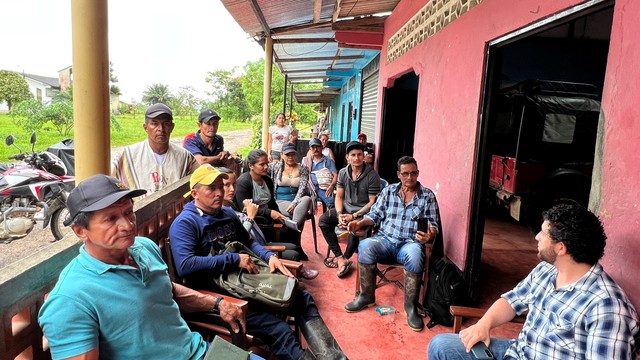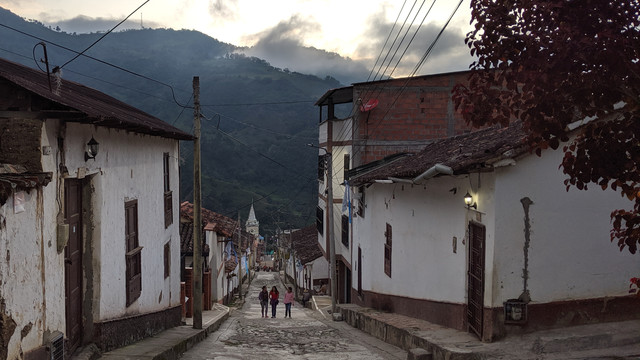Environmental Funds: sustainable finance for conservation
Spotting a worthwhile project is easy — but how do you fund it? Luckily for conservation and biodiversity, in the early 1990s a mechanism called 'Conservation Trust Funds', or 'Environmental Funds (EF)' emerged. And they work — as I've found from my experience in Colombia.


Weighing sacks of coffee beans in Colombia's southwestern Cauca department (Photo: Neil Palmer/CIAT)
After studying economics and business at university I knew I wanted to work in an organisation that supported environmental and social initiatives. A couple of months after graduation I got my first full time job: at Fondo Acción, Colombia's EF. I knew very little about the organisation then, and was surprised to find it supported more than 700 projects across Colombia.
Fondo Acción was unlike any other non-profit organisation I had read about or volunteered with. For a start, it took its financial sustainability seriously, carefully setting up, investing and managing its funds to provide long-term resources. And rather than running projects, it invited other organisations to propose (and then implement) projects around a topic of interest. Projects and organisations to be supported were selected through a call for proposals and had both internal and external evaluations that followed a carefully detailed procedure.
But, perhaps most importantly, Fondo Acción was building best practices and sharing what it learnt in discussions coordinated by the Latin American and Caribbean Network of Environmental Funds (RedLAC) and by other EF from Africa.
Shared stories
In RedLAC meetings, Fondo Acción shared its experiences of investing in crowdfunding, working with extractive companies and teaching rural communities sustainable fishing practices. It was in these meetings that I first learnt that EF exist and operate in similar ways in countries including Mexico, Panama, Dominican Republic, Brazil, Uruguay, South Africa, Uganda, Madagascar and Bangladesh, among others.
I saw clearly how EF are independent legally-constituted grant making institutions that provide funding for biodiversity conservation, protected areas, sustainable development and/or broader national or regional conservation objectives. EF are usually established through donations or grants from bilateral and multilateral cooperation, and from philanthropists, and these funds are then managed to ensure long term financial sustainability. A percentage of these administered funds is assigned to projects, selected through open calls for proposals.
Examples from ecotourism
One project I have been involved in while with Fondo Acción is a capacity building project for six grass roots ecotourism organisations offering lodging and dining services in cabins located in Colombia’s national protected areas. This project was created in 2009 by Fondo Acción and a Chilean corporation called PROCASUR, and is still thriving.
Available funding, interest and cooperation from grass roots organisations, and key partners (such as the Colombian hotel chain Grupo GH) are what made the project viable. Through it, the grass roots organisations have travelled to Peru, to Ecuador and within Colombia to learn about hotel management and food services. The organisations have been given equipment and books, and some have received professional coaching sessions to improve communication and leadership skills.
I have seen these grass roots organisations transform themselves. Many of them did not know what a 'technical standard' was and did not use hotel terminology when they started. Now they have set up their own internal procedures, and participate in national and international events to share their ecotourism experiences.
In my opinion, this successful capacity building has happened because there has been time to build trust between the six companies and Fondo Acción. The overall project has been able to adapt to the organisations' needs and there have been resources to finance the activities.
Review and record
So what can be done to help this approach gain even more traction?
I applaud IIED's recently published Review of Conservation Trust Funds for Sustainable Marine Resources Management. It's an illustrative and insightful paper about the main traits and the various types of EF in Latin America, the Caribbean, Asia and Africa. Its semi-structured interviews and literature review presents 12 Environmental Funds, exhibiting their institutional structure, how they generate funds, how they deliver them, and the lessons they've learnt.
I wish I'd had such a review when I began working in Fondo Acción in 2009! It would have been extremely valuable to get me 'up to speed' on EF. Reading it, it's clear that conservation trust funds have proven successful in attracting funding for conservation and sustainable development around the world.
But we still need to better measure and quantify their impact on conservation, and work to tell the stories of the lives these funds help transform. Hopefully a future IIED paper will be able to share these success stories, as well as the success of fundraising efforts.
Ann Marie Steffa was the executive secretary of the Latin American and Caribbean Network of Environmental Funds (RedLAC) from January 2012 through June 2014. She also worked in Fondo Acción, Colombia from May 2009 through December 2011.
 Read the IIED publication A review of conservation trust funds for sustainable marine resources management: Conditions for success.
Read the IIED publication A review of conservation trust funds for sustainable marine resources management: Conditions for success.
The report covers 12 case studies from Africa, Asia, Latin America, the Caribbean, and Australasia, providing a broad overview of how to create a CTF, describing its legal and institutional structure, fund generation and delivery, and identifying when it might be an appropriate tool. It shares best practice and insights into what makes such funds sustainable and successful, and hence valuable to conservation.




